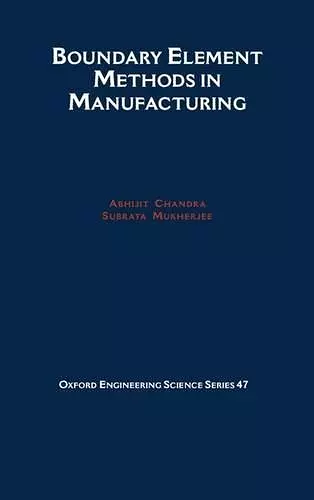Boundary Element Methods in Manufacturing
Subrata Mukherjee author Abhijit Chandra author
Format:Hardback
Publisher:Oxford University Press Inc
Published:12th Jun '97
Currently unavailable, and unfortunately no date known when it will be back

Manufacturing processes have existed, in some form, since the dawn of civilization. Modelling and numerical simulation of mechanics of such processes, however, are of fairly recent vintage; made possible, mainly by improved understanding of the fundamental mechanics and physics of these processes as well as by the availability of ever more powerful computers. Our capabilities of designing manufacturing processes, however, significantly lag behind our abilities in simulating such processes. In fact, research in the area of design of manufacturing processes is barely a decade old. Analysis of manufacturing processes, and its integration into the design cycle of these processes, are the dual themes of this book. The boundary element method (BEM) is the computational method of choice. This versatile and powerful method has enjoyed extensive development during the last two decades and has been applied to virtually all areas of engieering mechanics (both linear and nonlinear) as well as in other areas. The BEM infra-structure is presented in Chapters 2, 3, and 4. Chapters 2 and 3, respectively provide reviews of the fundamentals of nonlinear and thermal problems. Material and geometric nonlinearities are ubiquitous in manufacturing processes such as forming and machining while thermal issues play significant roles in casting and machining processes. Chapter 4 discusses design sensitivity analysis, and provides an avenue for utilizing insights gained from analysis toward design synthesis of manufacturing processes. Chapters 5 through 9 are devoted to detailed discussions of a broad range of manufacturing processes - forming, solidification, machining, and ceramic grinding. The unique features of this book are its emphasis on numerical simulation as well as on design of manufacturing processes, and the use of the boundary element method as the computational method of choice.
"This work can be used as a reference book in a graduate course in boundary element methods applied to manufacturing. Boundary Element Methods in Manufacturing, which is written by experts in the field and is full of original current research, should be of immense interest to researchers, engineers, scientists, and graduate and postgraduate students who are interested in computational solid mechanics and heat transfer as applied to manufacturing."--Applied Mechanics Review "This work can be used as a reference book in a graduate course in boundary element methods applied to manufacturing. Boundary Element Methods in Manufacturing, which is written by experts in the field and is full of original current research, should be of immense interest to researchers, engineers, scientists, and graduate and postgraduate students who are interested in computational solid mechanics and heat transfer as applied to manufacturing."--Applied Mechanics Review
ISBN: 9780195079210
Dimensions: 241mm x 160mm x 31mm
Weight: 933g
528 pages